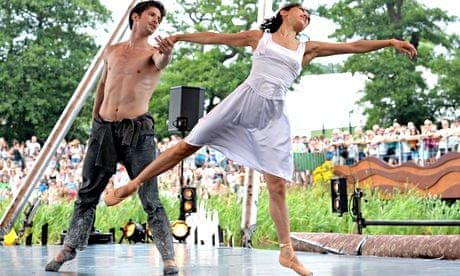It is early morning in the arena at Latitude and the queue of festivalgoers at one of the coffee stalls is long. A man with a "production" lanyard barges to the front of the queue to vocal protests. He justifies himself by saying: "Without me, you lot wouldn't have anything to see." "Wrong," says a woman in the queue. "Without us you wouldn't have anyone to produce anything for. You need us."
Out by the main entrance to the arena, they are giving away samples of factor 50 sun cream. Complete strangers offer to rub sun cream into each other's backs. At one point there is a line of more than 40 people rubbing cream into each other's backs where they can't reach for themselves. It is spontaneous co-operation in action.
A few years ago I went to one of the meetings at the Arts Council organised by Brian McMaster when he was doing his report into excellence. There were about a dozen of us in the room, some running flagship institutions and museums or small arts centres. McMaster asked everyone in the room how they had become involved in the arts. Every single person, without fail, answered that it had been through participation, in most cases starting at school, which is why the marginalisation of arts subjects in state schools is worrying. You see lots of doing – not just watching – at Latitude, where the Dance East pagoda is the happiest place on the field, full of people dancing before they rush off to see Sadler's Wells performing on the Lakeside stage. Doing and watching are inextricably linked. The best advocates for the arts will come from those who do as well as watch.
At Latitude there is something called the Live Art tent. "That will be empty all weekend," observed a cynic as we passed on the first day. It wasn't. It was bursting at the seams at every single performance. Programmers in some of our major theatre buildings have told me that they cannot programme live art because audiences are scared of it and won't come. Nobody shows any sign of being scared of live art at Latitude. Maybe audiences are just much, much braver than programmers give them credit for.
I have a conversation in the shower queue about crowdfunding. The company I am talking to think they should be doing it. Maybe they should. But maybe the most interesting bit of the word crowdfunding is "crowd". At Latitude there is a children's area and there are shows in tents and sheds where only those over 18 are admitted. But, unlike with most arts activities, children and adults are enjoying music and the arts side by side and hand in hand. This is natural but, goodness, it's an unusual sight in the arts in this country, where theatre is often either for adults or children, but not both.
The audience at Latitude is not diverse and, with tickets costing as much as they do, there are almost certainly very few poor people there. Without diversity we will tell only stories we already know to each other. That's not a conversation; it's a dead end. We need to address it urgently, become more alert to our own privilege.
Doing shows on the hop, in less than ideal conditions, can be good for artists and their art. It stops prissiness creeping in; it makes them nimble and adaptable. Audiences will forgive the lack of production values; if the show is engaging they cease to hear the music drifting in from outside. The provisional is often much more interesting than the perfect. While Forced Entertainment are performing The Notebook in the Little House, a small crowd gathers outside to listen. I go off to do something else. When I return 20 minutes later, some of them are still there. Still listening. Rapt.
In theatre the audience is often fragmented. There are those who like new writing and so go to new writing theatres, those who like Shakespeare so they go to the RSC. And there are those who like circus. Festivals such as Latitude are a reminder that these demarcations are absurd. If we create the right opportunities, people will try anything: they won't just stick with what they know and think they like. Maybe the programmes of some of our theatre buildings should be more like Latitude, with curated, artist-led spaces.
If you went to Latitude, in whatever capacity, and observed something you think theatre and the arts could learn from, something they should try, or definitely shouldn't do, then do please post below.

Comments (…)
Sign in or create your Guardian account to join the discussion